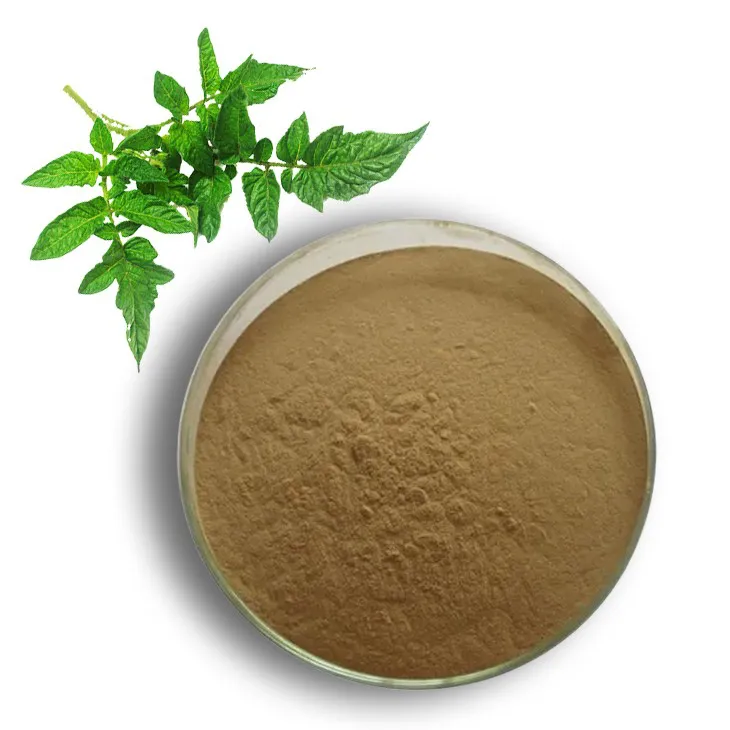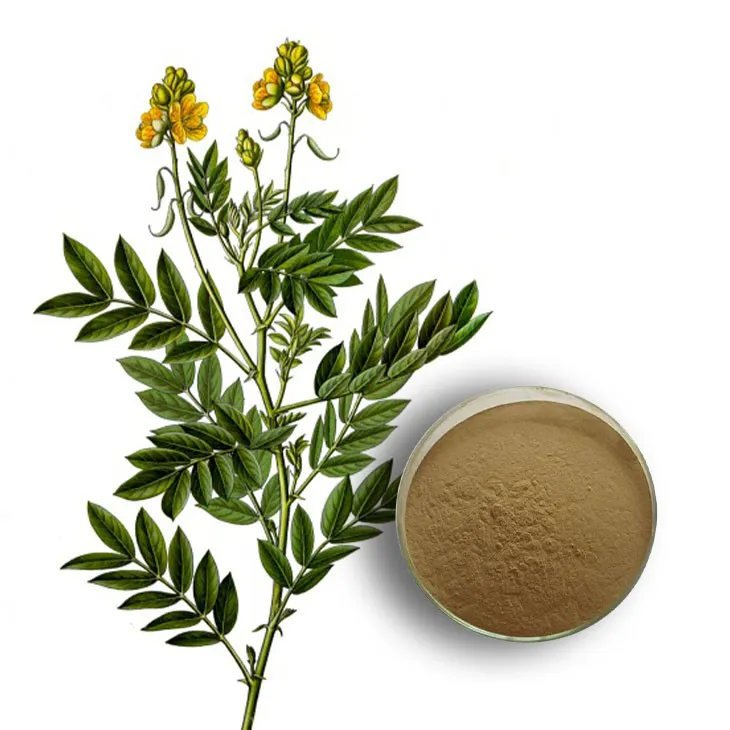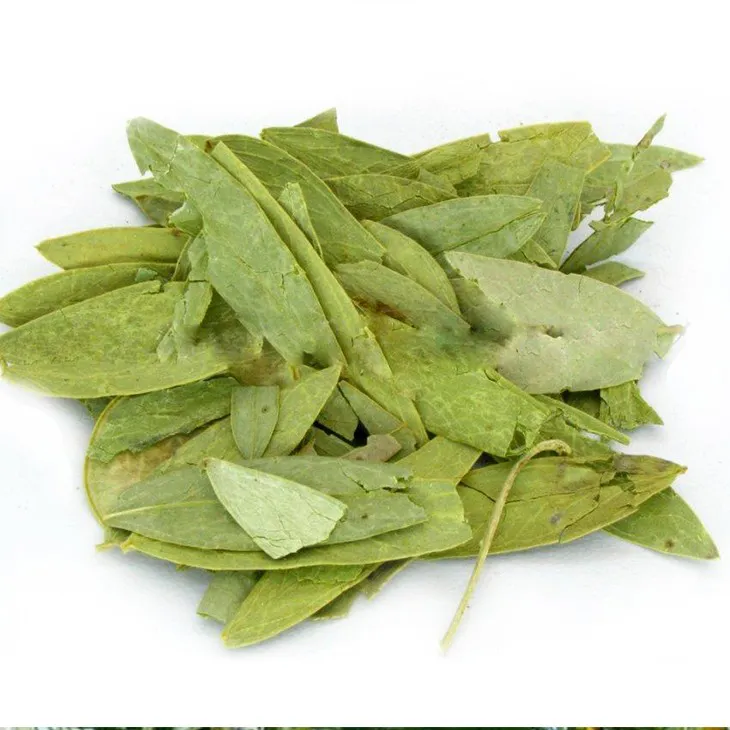- 0086-571-85302990
- sales@greenskybio.com
Active components in Senna leaf extract.
2024-11-28

1. Introduction
Senna Leaf Extract has been a subject of great interest in various fields due to its potential health benefits. The active components within this extract play crucial roles in exerting different physiological effects. Understanding these components is essential for further research and potential applications in medicine and health - related industries.

2. Anthraquinone Derivatives
2.1 Sennoside A and Sennoside B
Sennoside A and sennoside B are the most prominent anthraquinone derivatives in Senna Leaf Extract. These compounds are well - known for their laxative effect. When consumed, they undergo metabolism in the intestine. This metabolic process is quite complex. The anthraquinones interact with the intestinal cells and trigger a series of physiological responses.
Specifically, they lead to an increase in water and electrolyte secretion in the colon. The colon is an important part of the digestive system. With more water and electrolytes being secreted, the feces become softer. As a result, defecation is promoted. This is a natural way to relieve constipation. However, it is important to note that the use of Senna Leaf Extract containing these anthraquinones should be done under proper medical guidance, as excessive use may cause some adverse effects.
2.2 Other Anthraquinone Compounds
Besides sennoside A and sennoside B, there are other anthraquinone compounds in Senna leaf extract. These compounds may also contribute to the overall physiological effects of the extract. They might have similar or complementary functions to sennoside A and sennoside B in terms of interacting with the intestinal environment and influencing digestion - related processes.

3. Polysaccharides
The polysaccharides present in Senna leaf extract are another important group of active components. These polysaccharides are macromolecules with complex structures. They are believed to have immunomodulatory functions.
- One of the possible mechanisms is that they can interact with the immune cells in the body. For example, they may bind to certain receptors on the surface of immune cells, such as macrophages or lymphocytes.
- By doing so, they can modulate the activation and function of these immune cells. This modulation can potentially enhance the body's immune response against pathogens.
- Moreover, the polysaccharides may also play a role in maintaining the balance of the immune system. In some cases, an over - active or under - active immune system can lead to various health problems. The immunomodulatory properties of the polysaccharides in Senna leaf extract may help to keep the immune system in a stable and healthy state.

4. Phenolic Compounds
The phenolic compounds in Senna leaf extract are also active ingredients with significant properties. These compounds are known for their anti - inflammatory properties.
- Inflammation is a common physiological response in the body. However, chronic inflammation can be associated with many diseases, such as arthritis, cardiovascular diseases, and some types of cancer.
- The phenolic compounds in Senna leaf extract can potentially interfere with the inflammatory pathways in the body. They may act by inhibiting the production of inflammatory mediators, such as cytokines and prostaglandins.
- By reducing inflammation, these phenolic compounds may be beneficial for some inflammatory - related conditions in the body. For example, in cases of mild joint inflammation, the anti - inflammatory properties of the phenolic compounds may help to relieve pain and swelling.
5. Interaction between Active Components
The different active components in Senna leaf extract do not act independently. There are likely interactions between them.
- For instance, the anthraquinone derivatives, which are mainly responsible for the laxative effect, may influence the absorption or metabolism of the polysaccharides or phenolic compounds. This interaction could potentially affect the overall immunomodulatory and anti - inflammatory functions of the extract.
- On the other hand, the polysaccharides with their immunomodulatory functions may also have an impact on how the anthraquinone derivatives are metabolized in the body. This could in turn affect the laxative effect.
- The phenolic compounds, with their anti - inflammatory properties, may interact with both the anthraquinone derivatives and the polysaccharides. This complex web of interactions needs to be further studied to fully understand the overall efficacy and safety of Senna leaf extract.
6. Research and Future Perspectives
There is still much research to be done regarding the active components in Senna leaf extract.
- Firstly, more in - depth studies are needed to fully elucidate the mechanisms of action of each active component. For example, the exact molecular targets of the phenolic compounds in terms of their anti - inflammatory effects need to be identified.
- Secondly, the potential synergistic or antagonistic effects between different active components need to be explored in more detail. This will help in formulating more effective and safe products based on Senna leaf extract.
- Finally, long - term safety studies are essential. Although Senna leaf extract has been used for a long time in traditional medicine, modern scientific research needs to ensure its safety for long - term use, especially considering the different active components and their potential interactions.
FAQ:
What are the main active components in Senna leaf extract?
The main active components in Senna leaf extract are anthraquinone derivatives (such as Sennoside A and Sennoside B), polysaccharides, and phenolic compounds.
How do sennoside A and sennoside B in Senna leaf extract work as laxatives?
When ingested, sennoside A and sennoside B are metabolized in the intestine. This leads to an increase in water and electrolyte secretion in the colon, which softens the feces and promotes defecation.
What is the function of polysaccharides in Senna leaf extract?
Polysaccharides in Senna leaf extract may have immunomodulatory functions, potentially enhancing the body's immune system.
What are the benefits of phenolic compounds in Senna leaf extract?
Phenolic compounds in Senna leaf extract have anti - inflammatory properties and may be beneficial for some inflammatory - related conditions in the body.
Are there any other potential effects of the active components in Senna leaf extract?
While the laxative, immunomodulatory and anti - inflammatory effects are well - known, further research may uncover other potential effects of the active components in Senna leaf extract.
Related literature
- Analysis of Active Components in Senna Leaf Extract and Their Pharmacological Effects"
- "The Role of Anthraquinones in Senna Leaf Extract: A Comprehensive Review"
- "Polysaccharides in Senna Leaf Extract: Immunomodulatory Functions"
- ▶ Hesperidin
- ▶ citrus bioflavonoids
- ▶ plant extract
- ▶ lycopene
- ▶ Diosmin
- ▶ Grape seed extract
- ▶ Sea buckthorn Juice Powder
- ▶ Beetroot powder
- ▶ Hops Extract
- ▶ Artichoke Extract
- ▶ Reishi mushroom extract
- ▶ Astaxanthin
- ▶ Green Tea Extract
- ▶ Curcumin Extract
- ▶ Horse Chestnut Extract
- ▶ Other Problems
- ▶ Boswellia Serrata Extract
- ▶ Resveratrol Extract
- ▶ Marigold Extract
- ▶ Grape Leaf Extract
- ▶ blog3
- ▶ blog4
-
Standard - process pine bark extract powder.
2024-11-28
-
Nature's Bounty Almond Powder
2024-11-28
-
Organic Taurine Powder Suppliers.
2024-11-28
-
Bulk purchase of black pepper extract.
2024-11-28
-
Ginger extract of the best quality.
2024-11-28
-
Wholesale Passion Fruit Extract Suppliers.
2024-11-28
-
Kelp Extract Powder
2024-11-28
-
Hops Extract
2024-11-28
-
Tongkat Ali Extract
2024-11-28
-
Jujube Extract
2024-11-28
-
Saponin Extract
2024-11-28
-
Maitake Mushroom Extract
2024-11-28
-
Cocoa Extract
2024-11-28
-
Senna Leaf Extract
2024-11-28
-
Konjac Powder
2024-11-28
-
Cactus Extract
2024-11-28




















